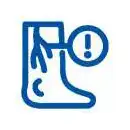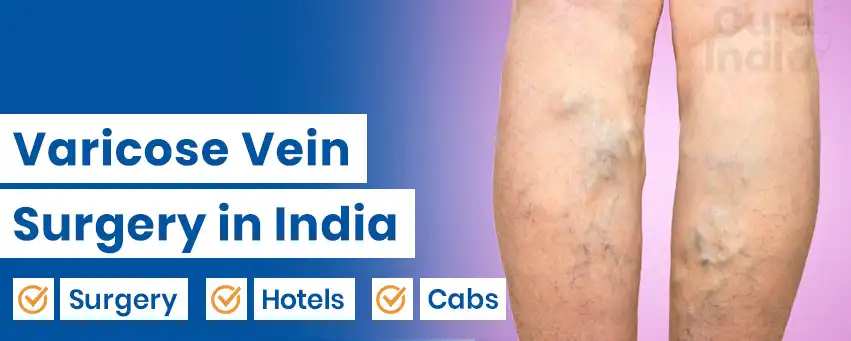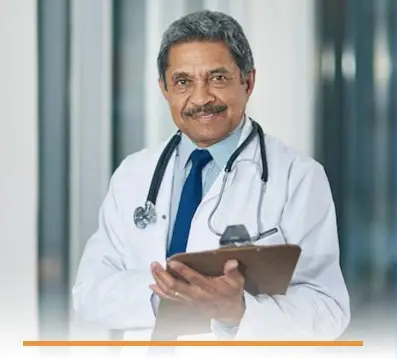

Varicose veins are swollen, enlarged veins that may be twisted and appear just beneath the skin, usually on the legs or feet. They may or may not be painful. Varicose veins appear as blue or purple veins, and they are often caused by a defect in the valves of the vein that maintains the blood flow. This defect allows the blood to flow in the wrong direction. The varicose veins can appear anywhere on the body, but it is mostly observed on the legs, ankles, and feet. It is because the legs are the part of the body where constant pressure is applied when we sit or stand for a long period of time, or maybe due to other reasons like obesity.
The cases of are increasing every year due to the increase in the sitting period of many adults, which may be due to desk jobs or any other reason. Sometimes the varicose veins are surrounded by spider veins, which are smaller and look like purple or red lines. In most of the cases, the varicose veins are not dangerous. However, in some cases, the condition may be severe and lead to complications like blood clots. The varicose vein symptoms can be cured at home, but sometimes proper medical varicose vein removal techniques like laser therapy, injections, or surgery are needed to cure the condition.
Due to the increase in the cases of varicose veins every year, many people from different countries travel for varicose veins surgery in India, seeking the right and safe medical care. From African countries also, many people from Tanzania, Kenya, Ethiopia, and Cameroon visit India for varicose veins operation. Not only for varicose veins but for several other medical conditions, Indian hospitals provide premium treatment and medical care. The varicose vein doctors, surgeons, nurses, and medical staff are internationally trained and have many years of experience. The communication gap is not a problem in India for international patients, as English is a known language spoken by the majority of medical staff. With the best healthcare infrastructure and premium medical care, the cost of varicose veins surgery in India is very low which is favourable for global patients as they cannot afford the treatment in many other countries.
There are various types of veins in the body, and they all look different when they become varicose. Based on their characteristics, there are different types of varicose veins; they are listed below.
These are also known as saphenous varicose veins as they involve saphenous veins that are present in the legs. When these veins become varicose, they appear like a thick and rope-like lump and become large, due to which they increase in size and protrude from the skin.
These veins appear red, purple, or green in colour and are thick, and they are grouped together and form a network that looks like a mesh that covers a broad area on the skin. These veins may or may not bulge on the skin.
Spider veins are also known as thread veins or telangiectasia varicose veins. These veins are generally thinner and smaller in size and appear blue or red in colour. They can be seen anywhere on the skin or any part of the body. As the name suggests, they spread and form the shape of a web. They do not cause any harm, and they do not bulge either.
The normal function of veins is to carry the blood from the different body parts towards the heart, whereas the normal function of arteries is to carry the blood from the heart towards the different parts of the body. The veins present in the legs have to work opposite to gravity to pump the blood from the legs to the heart. Tiny valves are present in the veins that help in this process. When these valves are damaged, they become weak, and as a result, they cannot function properly, and the blood starts to flow in the backward direction, which causes the veins to twist and results in bulging and swelling of the veins. There are many reasons why these vein valves become; they are mentioned below.
The very primary varicose veins signs symptoms are the appearance of deformed veins, which may be red, blue, green, or purple in color. You may or may not experience swelling, pain, or heaviness near the affected area. In very rare cases, these veins can cause discolouration and swelling. If the varicose veins are severe, they may form ulcers and bleed. Besides the appearance, the other common symptoms of varicose veins are listed below.
The varicose veins can be self-diagnosed, and to further confirm the condition, you can visit your doctor to check the other symptoms and severity of your varicose veins. For self-diagnosis, the signs and symptoms include bulging or swelling veins that may look red, purple, blue, or green in colour. These veins are most likely visible on the legs, usually near the calf region, and they slowly grow towards the other parts of the legs like the knees, thighs, ankles, and feet. When you stand for a few minutes by placing your leg in a certain position, it may start to feel heavy and a little painful and slowly start to feel a burning sensation accompanied by muscle cramps, itching, or throbbing near the affected area. When you have these symptoms, you should visit the doctor for a proper diagnosis and confirm the condition. When you consult the doctor, he/she will first conduct a physical exam to check the veins, their swelling, and if it is bulging or not. Then your doctor may run some tests, like an ultrasound or doppler test, to check if there is any presence of blood clots in the affected area.
The ultrasound test is performed to diagnose the veins deeply. An ultrasound scan helps to identify the presence of any damaged valves that are causing the blood to flow abnormally in the body. It is the most used diagnostic method for patients who have a history of vein thrombosis.
This is a similar ultrasound test that is used to examine the blood flow in the veins of the legs, arms, and other large arteries. It is a simple test that is non-invasive. During this diagnostic test, a gel is applied to the transducer of a medical device, and then the device is placed on the affected area. Then it is slowly passed on the skin above the varicose veins to check the conditions of the veins. This device uses sound waves to examine the veins and the arteries that need to be tested.





Many people from African nations like Kenya, Ethiopia, Tanzania travel to India seeking the best treatment at minimum cost. The doctors in India are highly experienced and experts in their own fields. The varicose vein hospitals in India have the latest technological approaches for providing a wide range of treatment options. Indian hospitals provide the treatments like EVLA, RFA, SVS, and EMVA for patients with varicose veins. The cost of Varicose Vein treatment in India is much cheaper than other countries in the west. The cost of Varicose Vein treatment in India is mentioned below
| Treatment Name | Cost in India | Stay in India |
|---|---|---|
| Varicose Veins Surgery in India | $2,500 | 7 Days |
In most cases, the varicose veins can be managed by self-care measures such as wearing compression stockings, exercising, keeping your legs raised when you sit or lie down, etc. Besides the self-care measures, there are some treatment procedures and surgeries that may help you with varicose vein removal. The surgical and non-surgical treatments for varicose veins are mentioned below.
The non-surgical treatment options for varicose veins include sclerotherapy and radiofrequency ablation therapy. These treatments are mentioned below.
■ Sclerotherapy:
This is a procedure that is used to destroy defective veins by injecting a solution known as sodium tetradecyl sulphate directly into the veins. By doing so, the blood vessels will route the blood flow to the healthy veins. When the veins are destroyed by injecting a solution, they disappear slowly over time. It is known as sclerotherapy when it is used for the small veins, like the spider veins, but it is known as foam sclerotherapy if it is used for the larger veins. In foam sclerotherapy, the solution that is to be injected into the veins turns into foam because the foam can cover the area of larger veins.
■ Radio Frequency Ablation Therapy (RFA):
This treatment procedure is also known as fulguration. In this process, a lesion is created with the help of a radiofrequency needle on the internal wall of a vein to close the varicose veins. This can also be done on the nerve that transmits the pin signals to the brain. When this nerve is damaged, it can no longer send pain signals to the brain.
The surgical methods for varicose vein removal surgery include endovenous laser ablation therapy, vein ligation and stripping, and transilluminated powered phlebectomy.
■ Endovenous Laser Ablation Therapy:
This procedure is also known as Endovenous Laser Treatment (EVLA). It is a minimally invasive procedure that uses an ultrasound as a guiding tool. It is similar to the RFA procedure; the only difference is that the RFA uses radiofrequency energy and this procedure uses laser energy. In this procedure, the veins are killed by using laser fibres. During this procedure, your surgeon will make a small incision in the skin and insert a catheter (tube containing laser fibre), which will be moved towards the varicose vein. After that, your surgeon will pull the catheter out, and while the catheter is pulled out, the laser fibre will heat the vein, causing the vein to close and then shrink. The cut that is made on the skin to insert the catheter will be so small that there is no need to close it with the stitches; it will be closed by itself.
■ Vein ligation and Stripping:
This procedure is mostly performed to prevent complications, such as blood clots, ulcers, etc., that a varicose vein might cause. In the vein ligation procedure, the surgeon makes about 2 to 3 incisions of about 5 cm on the affected area. After that, the veins will be ligated (tied). In the stripping procedure, the damaged vein will be removed. This procedure is used when the patient is suffering from varicose eczema and trophic ulcers because if they are not treated, it can start decomposing the skin and result in non-healing ulcers.
■ Transilluminated powered phlebectomy:
This is a varicose vein removal procedure that uses an endoscopic transilluminator device. This device illuminates the veins by using a bright light. During this process, the surgeon makes a few incisions at the affected site, and a transilluminator is placed below the skin to make the veins visible. Once the veins are identified by the surgeon, he/she will cut the vein, and with the help of a suction device, the vein will be removed via the incision site.
The recovery process of varicose veins surgery in India is simple and short. Based on the severity of your condition and the type of method used to treat your varicose veins, the recovery period may vary from patient to patient. However, the total time required to recover from this procedure is about 2 to 4 weeks. You will be discharged from the hospital usually on the same day of treatment, and before leaving the hospital, you will be given some instructions to follow at home for faster and smoother recovery and to avoid the varicose veins from reoccurring. The instructions include elevating the feet when you are sitting or sleeping, avoiding lifting heavy weights, and avoiding any strenuous activities at least for 2 weeks after the surgery. It is also important to walk a little to keep the blood flowing during the recovery process. Walking will prevent the formation of blood clots. In case you have pain and discomfort, your doctor will give you medicines to manage those symptoms.
Varicose veins generally do not cause any complications in the body. However, if the severity of varicose veins increases, it also gives rise to other problems in the body. Even if it can be managed at home, sometimes it requires medical help to ease the symptoms and remove the damaged veins. Due to the unavailability of proper varicose laser treatment procedures, many people from low-income countries are travelling to India for varicose vein removal surgery. As you can see in the above table, the varicose laser treatment cost is very low in India, and a wide range of treatment options are available for varicose vein removal. The medical staff in Indian hospitals are very hospitable and provide full patient support. If you have any queries before or after the treatment procedures, you can contact your surgeon and resolve the questions without any hesitations. You will receive world-class medical care at a very low cost in India. Considering undergoing varicose veins surgery in India can be a highly profitable option for global patients looking to get treatments in India.
